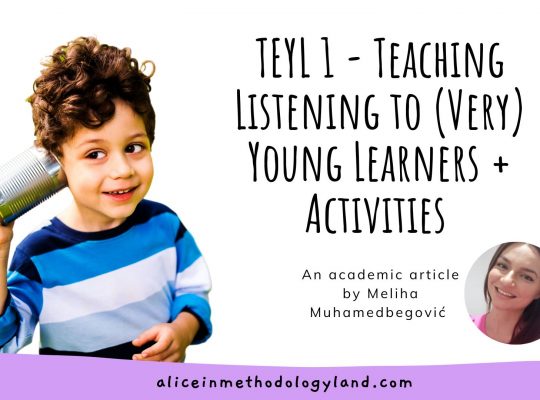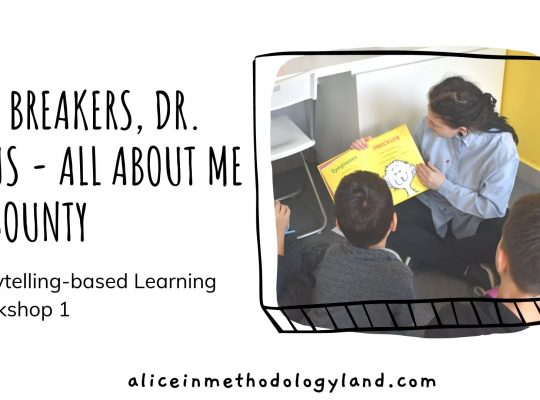Hello, my dear colleagues! My research related to bibliotherapy and storytelling with very young learners was finally published by the Faculty of Education in Jagodina, University of Kragujevac! I want to present the first part of the research here and share the meaning, types, and origins of bibliotherapy!
Research summary
The paper discusses the process of bibliotherapy with a focus on developmental bibliotherapy at the preschool age. In order to illustrate how bibliotherapy can affect a child’s development at the preschool age, the paper defines developmental bibliotherapy, outlines the implementation process, presents how particular segments affect the participants, shares relevant activities, discusses the role of the institution and competencies оf the educator needed for bibliotherapy. Keywords: developmental bibliotherapy, preschool age, methodical approach to bibliotherapy, teaching English to very young learners, storytelling, very young learners.
Please don’t forget to reference and link the paper to help it spread and reach more practitioners!
The origins of bibliotherapy: How did it all start?
The term bibliotherapy originated from the Greek word that means ’treatment’. There are several types of bibliotherapy defined based on their purpose of application. Although the term contains the word therapy, the approach does not necessarily have to be used and applied to treat psychological disorders.
Gregory and Vessey (2004) define bibliotherapy as using “books to help people solve problems”.
Bibliotherapy can be seen as a complex name for a process used by various professionals who work with both adults and children. In this process, the institution supports the participants in everyday situations (positive or negative) that inevitably occur as part of complex social and emotional environments.
From theater to psychologists
The roots of bibliotherapy date back to Ancient Greece, where the idea of improving the state of mind through books was ubiquitous, as evidenced by the inscription located at the entrance of the library in You, which reads “A place for healing souls”. The Alexandrian library contains an epigram that reads: “Reading is the medicine of the mind”. The Egyptians prescribed the words as a medicine, claiming that with the help of the word, a man whose psyche suffers can recover and heal psychologically.
As the first theorist of tragedy, Aristotle defined catharsis, which had a vast influence on the formation of the bibliotherapy process. Catharsis caused the present audience to experience empathy and led them to refine and change their opinions. He believed that catharsis reminded us of the seriousness of life and
enabled introspective observation of a dilemma, which was a fundamental principle for the development of bibliotherapy.
Getting recognized as a form of treatment
Although the idea was conceived in Ancient Greece, bibliotherapy as a form of treatment did not appear in the general public until the 18th century, when Dr. Benjamin Rush (Weimerskirch 1965) recommended reading as a part of therapy and treatment. He used the Bible and other religious texts for the
bibliography process. During the early 1900s, French psychiatrist Pierre Janet (O’Bruba, Camplese 1979) believed that patients could be directed towards a better life by reading adequate literature and analyzing it.
Bibliotherapy was eventually recognized as a type of library activity (Pardeck 1994). It was defined
in Dorland’s (1890) illustrated medical journal, even though John Gait published the first printed treatment using bibliotherapy in 1840 (Cardenas 1980). After that, bibliotherapy became internationally recognized, and many psychiatrists and social workers began to use bibliotherapy in a clinical setting.
Boosting problem-solving and overall child development
The main goal is to aid in problem-solving and personality development, and growth (Lenkowsky 1987; Adderholdt-Elliott, Eller 1989). Also, Marković (2015) points out that bibliotherapy has many diverse functions determined based on the needs of the participants. The participants’ needs can range from medical and clinical to developmental and preventative. The last two mentioned functions are primarily used in education to aid children in dealing with discomfort, unpleasant feelings, and many other conditions and situations that the child encounters (Hebert, Kent 2000; Rozalski, Stewart, Miller 2010).
Given the efficacy of this approach, educators can apply it in preschools to explore the possibility of overcoming everyday difficulties with their learners.
According to Forgan (2002), the developmental difficulties in most preschoolers include anger, teasing, intimidation, and lack of understanding of oneself. The inability to understand details, situations, and feelings at a given moment causes an emotional burden on the child. Hence, bibliotherapy is an effective
way to relieve stress and boost overall wellbeing (Lucas, Soares 2013; Suvilehto, Kerry-Moran, Aerila 2019). Children can identify with imaginary characters by exploring stories and characters in fictional locations with fantastic elements.
The fundamental types of bibliotherapy
To understand the process of bibliotherapy in more detail, the aims, means, and environment in which it is applied, we can divide bibliotherapy into the following categories:
- Institutional bibliotherapy, conducted by a psychiatrist or librarian (in an institution or privately), is a passive therapeutical method. The literature is analyzed through discussion to give insight into the patient’s condition, and the technique is often applied in correctional facilities.
- Clinical bibliotherapy is performed willingly or unwillingly (in institutions or privately). This type of bibliotherapy is active and conducted by a psychiatrist or librarian. Psychiatrists and librarians are regarded as trained professionals who aim to help people who struggle with emotional and behavioral disorders and problems while encouraging introspection and socially acceptable behavior (Marković 2015: 53; Suvilehto, Kerry-Moran, Aerila 2019).
- Developmental bibliotherapy is the subject of interest in this paper. Although therapy appears in the name of this process, this approach has a different aim compared to other types of bibliotherapy. Developmental bibliotherapy is used in situations to aid in conflict resolution and address developmental needs. The use of this approach has a positive effect on the child’s emotional development, including wellbeing (Pardeck, Pardeck 1989; Lucas, Soares 2013).
Developmental Bibliotherapy in Storytelling with very Young Learners
The term developmental bibliotherapy was established by Margaret Monore, who considered it necessary to define bibliotherapy as a method used with adults and with children. Today, we view bibliotherapy as “a new strategy that can be used in the clinical environment and as a technique to help children fulfill their needs” (Afolayan 1992; Jackson 2006: 5). Using bibliotherapy is considered an effective way to encourage or discourage behavior patterns (Myers 1998) and can have a corrective and a formative purpose, so it is necessary to understand the different types of bibliotherapy depending on the aims for their application. Types of bibliotherapy according to their use Bibliotherapy is implemented in practice by experts from diverse fields, and although the general aims of bibliotherapy are seemingly the same, there are significant differences between the types of bibliotherapy. Interdisciplinaryness is present in all forms of bibliotherapy, and the staff that leads the process needs to possess a wide range of skills.
More details about this method coming up in future articles!
To conclude
After reading this research brief, can you see yourself applying such a method in your ESL classroom? What seems the most interesting in the development of bibliotherapy? Let me know down in the comments, or via the contact page.
All references from the whole paper
- Adderholdt-Elliott, Eller (1989): Miriam Adderholdt-Elliott, Suzanne H. Eller,
- Counseling students who are gifted through bibliotherapy, Teaching Exceptional
- Children, 22(1), 26‒31.
- Afolayan (1992): Johnson A. Afolayan, Documentary perspective of bibliotherapy in education, Reading Horizons: A Journal of Literacy and Language Arts, 33(2), 5.
- Bašić (2011): Ivana Bašić, Biblioterapija i poetska terapija: priručnik za početnike, Zagreb: Balans centar.
- Betelhejm (1979): Bruno Betelhejm, Značenje bajki, Beograd: Prosveta.
- Brown, Blyth (2016): Paul Brown, (illustrated by) Rowena Blyth, The Mood
- Hoover, Fourth Wall Publishing.
- Bronson, Bronson (2001): Martha B. Bronson, Martha Bronson, Self-regulation
- in early childhood: Nature and nurture, Guilford press.
- Cardenas (1980): Marry Ellen Cardenas, Bibliotherapy: Good book or media
- selection plus a definite goal, ERIC Document Reproduction Service No. ED 191 484.
- Cooper (2007): Patricia M. Cooper, Teaching young children self-regulation
- through children’s books, Early childhood education Journal, 34(5), 315‒322.
- Dorland (1825): William Alexander Newman Dorland, Dorland’s Illustrated
- Medical Dictionary, WB Saunders.
- Еr (2013): Sühendan Еr, Using total physical response method in early childhood foreign language teaching environments, Procedia ‒ Social and Behavioral Sciences, 93, 1766‒1768.
- Forgan (2002): James W. Forgan, Using bibliotherapy to teach problem solving,
- Intervention in School and Clinic, 38(2), 75‒82.
- Gardner (1993): Howard Gardner, Multiple intelligences: The theory in practice,
- Basic books.
- Gregory, Vessey (2004): Katherine E. Gregory, Judith A. Vessey, Bibliotherapy: A strategy to help students with bullying, The Journal of School Nursing, 20(3),
- 127‒133.
- Huang (2006): Hui-Ling Huang, The effects of storytelling on EFL young learners’ reading comprehension and word recall, English Teaching & Learning, 30(3),
- 51‒74.
- Jackson (2006): Marilyn N. Malloy Jackson, Bibliotherapy Revisited: Issues in
- Classroom Management. Developing Teachers’ Awareness and Techniques to Help
- Children Cope Effectively with Stressful Situations, Mangilao, Guam: M-m-mauleg
- Publishing.
- Kersten, Rohde (2014): Kristin Kersten, Andreas Rohde, Teaching English to
- young learners, Language acquisition and use in multilingual contexts, 107.
- Lenkowsky (1987): Ronald S. Lenkowsky, Bibliotherapy: A review and analysis
- of the literature, Journal of Special Education, 2(2), 123‒132.
Click here to explore Alice’s material website, where ESL materials are forever free!

All the materials except lesson plans and 30+ page interactive activity books will be free FOREVER! Why? Because sharing is caring, and the last couple of years haven’t been kind to all of us.
Don’t forget to leave a review when you download materials! It’s just a minute of your time, and it means a lot to Alice as a material designer.
P.S. The store and the freebie library are not the same thing – the freebie library has some extra materials like conference presentations and webinar recordings which are not available in the store
The subscription link for the store is below the author’s bio in every post.

*Our posts may contain affiliate links, which is one of the ways we can keep operating.






